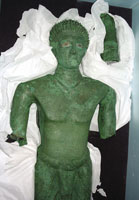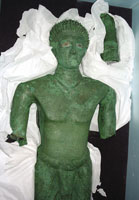
Bronze Man statue back in Yemen [Archives:2007/1098/Last Page]
October 25 2007
 |
Yemen welcomed home its Bronze Man statue on Oct. 26 from the Louvre Museum in Paris where it had been for nearly 10 months for repair.
Abdullah Ba Wazeer of the Public Authority of Antiquities and Museums said,
“The Louvre doesn't have anything like this bronze masterpiece statue. Experts in charge of repairing and studying it were amazed at its scrupulous workmanship.”
This magnificent statue will help Yemen increase and promote its tourism programs, he noted, adding that it will be the center of attraction and interest for both Arab and foreign tourists.
According to Ba Wazeer, the statue's repair at the French museum is regarded as an initiative for future cooperation, adding that sometime between Nov. 9 and 12, Yemen is expecting to receive another statue known as Henri Lori in a ceremony inaugurated by the director of Louvre.
“There will be more collaboration with the Louvre in the future. When Henri Lori arrives here, we'll discuss more opportunities and strategies for exchanging and repairing antiquities,” Ba Wazeer assured.
Dating back to the sixth century B.C., the Bronze Man statue is a unique masterpiece at the National Museum and its height, body and sides make it one of the world's rare antiquities. Made of bronze and filled inside with burnt mud, the statue's body is quite soft, which is very rare.
Dr. Abdulaziz Al-Jindari, director of the National Museum in Sana'a, stated, “Our museum now is complete by receiving the Bronze Man statue, as it's the most valuable antiquity.”
He continued, “The statue's presence in the Louvre was an unusual advertisement for Yemen and its history. Many who saw it became more aware about the existence of Yemen, which is very beneficial for tourism.”
According to Al-Jindari, the importance of repairing the statue not only was for maintenance, but also for study. After it was cleaned, 12 inscriptions were discovered written on its body in the ancient Yemeni language known as Al-Musnad.
Ba Wazeer remarked that before being sent to the Louvre, the Bronze Man statue was dirty and subject to deterioration. “Additionally, we couldn't study it, but many things have changed since its repair; for example, the 12 inscriptions that were unseen, but now we can read what's written,\” he explained.
Officials assure that further research will be done on the Bronze Man statue to learn more about it.
According to National Museum officials


